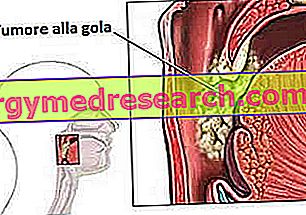Generality
Throat cancer is commonly understood as a malignant neoplasm that originates in one of the anatomical structures that make up the throat, such as the larynx, pharynx and palatine tonsils.

Figure: example of throat cancer.
From the site: cancer.uvahealth.com
The precise causes of this tumor have not yet been recognized; however, doctors and scientists believe that the list of main risk factors includes the use of tobacco and the abuse of alcoholic beverages.
The main pathological manifestations of throat cancer are: hoarseness, difficulty swallowing and sore throat.
For a correct diagnosis, doctors use different tests, including a local biopsy.
Therapy depends on the location and severity of the tumor. For stage I throat tumors (mild), radiotherapy combined with chemotherapy may be sufficient. For more serious tumors, however, surgery becomes necessary.
A brief review of what a tumor is
In medicine, the term tumor identifies a mass of very active cells, able to divide and grow uncontrollably.
- We speak of a benign tumor when the growth of cell mass is not infiltrative (that is, it does not invade the surrounding tissues) and even metastasizing.
- There is talk of a malignant tumor when the abnormal cell mass has the ability to grow very quickly and to spread to the surrounding tissues and the rest of the body.
The terms malignant tumor, cancer and malignant neoplasia are to be considered synonymous.
What is throat cancer?
Throat cancer, or throat cancer, is a malignant neoplasm that can develop in the pharynx, larynx, or palatine tonsils.

Figure: sections that make up the pharynx (highlighted in red) and anatomical parts adjacent to them (in black). From the site: memorize.com
But what exactly are pharynx, larynx and palatine tonsils?
PHARYNX
The pharynx is a muscle-membranous conduit about 13 centimeters long, covered by a mucosa and located between the nasal cavity and the esophagus. To be even more precise:
- Postero-inferior to the nasal cavity (ie behind and lower than the nasal cavity)
- Back to the mouth
- Above the esophagus and larynx
The pharynx is a fundamental trait of the upper digestive airways, which are so called because they allow both the progression of food to the esophagus, and the passage of air destined for the lungs for breathing.
Starting from the nasal cavity and descending towards the esophagus, three compartments can be recognized in the pharynx: the nasopharynx (or nasopharynx ), the oropharynx and the hypopharynx (or laryngopharynx ).
LARYNX
The larynx is an unequal tube of tubular form, located at the level of the neck, before the beginning of the trachea . Last stretch of the upper airway (the trachea is, in fact, considered the first tract of the lower airways), it is made up of different cartilaginous, muscular and ligamentous structures.

Figure: the larynx and the main cartilaginous structures that constitute it are highlighted in red. From the site: ponsuke2.s98.xrea.com
Seat of the vocal cords, the larynx performs three fundamental functions:
- It channels the air towards the trachea, then towards the lungs.
- It allows speech, through the vibration of the vocal cords.
- Thanks to a cartilage valve called epiglottis, it prevents food, which is about to be swallowed, from entering the trachea and obstructing the airways.
Externally, the larynx can be placed at the so-called Adam's apple (anterior protrusion of the neck more evident in men than in women).
TONSILLE PALATINE
The palatine tonsils - which are commonly referred to as the sole (albeit imprecise) term of tonsils - are two symmetrical lymphoglandular organs, with an anti-infective and immune function.
Located at the bottom of the oral cavity (in a position known as the isthmus of the jaws ), they have the task of defending the organism from bacterial and viral infections typical of the buccal cavity and the nasal cavity.
THROW IN THE THROAT IS ALMOST ALWAYS A SPINOCELLULAR CARCINOMA
Spinocellular carcinomas are malignant tumors of the skin other than melanoma, which originate in so-called squamous cells .
In 9 cases out of 10, throat cancer is a spinocellular carcinoma (or squamous carcinoma ).
In the remaining case, it may have the same characteristics as Kaposi's sarcoma or a mucinous adenocarcinoma (ie a neoplasm that develops from the cells that produce mucus).
NB: unlike the cells present in the skin, the squamous cells present in the mouth and throat lack a protein called keratin .
Epidemiology
Throat cancer is generally a rare cancer that predominantly affects people aged 60-70 years.
According to a recent statistical study referring to 2014, in the USA, new cases of laryngeal and pharyngeal cancer were 12, 630 and 14, 410, respectively.
Throat cancer is more frequent among male people: for example, for laryngeal cancer we speak of a male: female ratio of 4: 1.
Causes
Similarly to any other neoplasm, throat cancer is also the consequence of a series of genetic mutations affecting cell DNA (in this case cells belonging to the pharyngeal, laryngeal or tonsillar tissue).
These mutations - which usually involve a single cell, from which other mutated cells originate through mitosis - are responsible for the uncontrolled process of cell division and growth, typical of a neoplasm.
The precise causes of these genetic changes are often unclear; however, in the case of throat tumors, doctors believe that a key role is played by some risk factors :
- Tobacco, in whatever form of use: therefore cigarettes, cigars, pipe, chewing tobacco, etc.
- Alcohol abuse.
- Human papilloma virus infections (or HPV from the English Human Papilloma Virus ).
- A diet low in vegetables and fruit .
- Advanced age . According to various statistical studies, throat cancer is much more common among individuals over the age of 60.
- Exposure to dust, fumes and toxic substances that can spread in the air and be inhaled. The people most exposed to these substances are those who work in factories or industrial plants.
TYPES OF CANCER AT THE THROAT
Depending on where the neoplastic mass is formed, throat cancer takes on different names. In fact, there are:
- Nasopharyngeal cancer . It is a pharynx tumor that develops from the nasopharynx (or nasopharynx).
- Oropharyngeal cancer . It is a tumor of the pharynx that has, as a starting point, the oropharynx.
- Hypopharyngeal cancer . It is a tumor of the pharynx that develops starting from the hypopharynx (or laryngopharynx).
- Glottic cancer . It is a tumor of the larynx which has, as a starting point, the vocal cords.
- Supraglottic cancer . It is a tumor of the larynx that begins at the level of the supraglottis or epiglottis.
- Subglottic cancer . It is a tumor of the larynx that begins to develop from the subglottis (or in any case from the area below the glottis).
- Tonsillar cancer . It is the tumor that begins with the palatine tonsils.
Symptoms and Complications
The typical symptoms and signs of a throat cancer are:
- Hoarseness . Hoarseness is the change in tone (or timbre) of the voice. It is a common sign in all throat cancers, but is particularly marked in laryngeal cancers.
- Cough
- Difficulty swallowing. Such difficulties usually manifest themselves with pain while eating .
- Ear pain
- Sensation of having something, like a lump, in the throat
- Persistent sore throat
- Weight loss. It is due to swallowing problems, which prevent the patient from eating according to their needs.
- Breathing difficulties. They occur if the tumor mass somehow blocks the passage of air along the pharyngo-laryngeal tract.
- Swollen lymph nodes on the neck
See also: Symptoms of Laryngeal Tumors
WHEN TO REFER TO THE DOCTOR?
If the aforementioned symptoms are particularly severe or last for more than two weeks (without showing any improvement), you should immediately contact your doctor to investigate the situation.
For example, hoarseness should arouse suspicion when it has been going on for at least 2-4 weeks.
COMPLICATIONS
If not treated appropriately, throat cancer can spread some malignant cells into the rest of the body, going to affect nearby lymph nodes and then extending to some organs (such as the liver).
The process that causes a tumor to spread, in the rest of the body, its malignant cells is called the metastatic process or more simply metastasis .
Diagnosis
To diagnose a throat tumor, the doctor usually begins with a thorough analysis of the symptoms reported by the patient (physical examination), then examining his clinical history (pathologies suffered in the past, health at the time of analysis, etc.)
Subsequently, an endoscopy, a laryngoscopy, a tissue biopsy and diagnostic imaging tests may be necessary. The use of these in-depth examinations is essential to establish the characteristics and severity of the tumor, planning appropriate therapy accordingly.
EXAMINATION OBJECTIVE
During the physical examination, the doctor visits the patient and asks him to describe the symptoms experienced and how long they have been in progress.
Having done this, investigate the possible causes of throat problems by asking the individual under examination whether he is a smoker, if he frequently abuses alcohol or if he works in some industrial plant.
In the presence of one or more of the aforementioned circumstances, the hypothesis that the complained disorders are linked to a throat cancer becomes stronger.
ENDOSCOPY AND LARINGOSCOPY
Endoscopy is a medical procedure that allows you to inspect an individual's throat for abnormalities. The instrument used for endoscopy is the endoscope ; the endoscope is a kind of probe equipped with light and a camera connected to a monitor, for the projection of images.
Alternatively or in addition to endoscopy, the doctor also sometimes uses laryngoscopy . Laryngoscopy is the exploration of the larynx, performed with an instrument called a laryngoscope ; the laryngoscope, like the endoscope, has a camera connected to a monitor, on which it reproduces what is taken up.
TISSUE BIOPSY
Tissue biopsy consists of the collection and analysis in the laboratory of a sample of cells from the tumor mass.
Sampling is generally performed during endoscopy (or laryngoscopy), especially if these show the presence of something abnormal in the pharynx, larynx or tonsils.
DIAGNOSTICS FOR IMAGES
Through CT ( computerized axial tomography ), nuclear magnetic resonance, X-ray or PET ( positron emission tomography ), the doctor can see if the tumor has spread to the neighboring lymph nodes and other organs of the body.
TACs, X-rays and PET require exposure to a minimum dose of harmful ionizing radiation.
GRAVITY OF THE TUMOR: THE TUMOR STAGES
The severity of a tumor depends on the size of the neoplastic mass and the ability of the tumor cells to spread. There are 4 stages of gravity; these stages are distinguished from one another by the first four Roman numerals.
Stage I identifies the least severe tumors, confined to a precise location; Stage IV, on the other hand, identifies the most severe and widespread tumors, even spread in the lymph nodes and other organs of the body (usually the liver). Stages II and III mark tumors of intermediate severity.
Treatment
The therapy to be taken in case of throat cancer depends on:
- Location and stage of neoplasia
- State of health of the patient
Generally, if the throat cancer is stage I, radiotherapy is used, sometimes combined with chemotherapy; if, on the other hand, it is stage II or more serious, surgery is also indispensable.
RADIOTHERAPY
Radiation therapy involves exposing the tumor mass to a certain dose of high-energy ionizing radiation (X-rays), in order to destroy neoplastic cells.
As anticipated, it represents the treatment of choice for less severe throat tumors (therefore not very extensive and confined to well-circumscribed areas), but can also be a valid support for surgery in cases of serious or very serious malignancies.
Unfortunately, radiotherapy is not without side effects.
The X-ray source may be external or in close contact with the tumor
The source that releases ionizing radiation can be a machine specifically designed to give off X-rays and where the patient finds a place (external radiotherapy); or it can occur in the form of very small radioactive material, which can be placed near the tumor to be treated ( brachytherapy ).
Brachytherapy has the advantages of being highly specific and very fast (NB: for any additional information on this, we recommend that you consult the article on brachytherapy on the following page).
CHEMOTHERAPY
Chemotherapy consists of the administration of drugs capable of killing all rapidly growing cells, including cancer ones.
It is often combined with radiotherapy to make it more effective. However, it must be remembered that, with the combination of chemotherapy and radiotherapy, the side effects of each treatment are more likely to occur.
| Main side effects of chemotherapy | Main side effects of radiotherapy |
Nausea He retched Hair loss Sense of fatigue Vulnerability to infections | Teeth fall Sense of fatigue Mandibular stiffness Inflammation of the mouth Bleeding gums Dry mouth |
SURGERY
The type of surgical operation varies depending on the location and stage of the tumor. It is possible, in fact, to resort to:
- Endoscopic resection . Endoscopic resection is reserved for tumors that are small and limited in a limited area. It is so called because the removal takes place through an endoscope, which is used by the operating surgeon as a guide tool for the removal of the tumor mass.
- Laryngectomy . Laryngectomy is the laryngeal removal procedure. Practiced on the occasion of laryngeal tumors, it may be partial or total, depending on the extent of the neoplasm.
In the case of total laryngectomy, the patient is no longer able to breathe properly; therefore, in these situations, the tracheotomy operation is also provided, with which the respiratory capacity is restored.
- Pharyngectomy . Farigectomy is the removal and partial reconstruction of the pharynx. Practiced in the presence of a pharyngeal tumor, it may involve part or all of the pharyngeal tract.

Interventions of the aforementioned type require special preparation and, like any surgical operation, are not completely free from risks / complications.
Among the possible complications, it is worth noting:
- Difficulties in speaking normally
- The problems with chewing
- Difficulties in breathing adequately
- Difficulties in swallowing and eating sufficiently
For each of these drawbacks, there is the possibility of undergoing a specific rehabilitation therapy, which allows to recover, at least in part, the normal capacity.
OTHER ANTITUMOR DRUGS
There are anticancer drugs, such as Cetuximab, which act specifically against neoplastic cells, as these have very specific characteristics, different from those of healthy cells.
Several scientific studies have shown that Cetuximab can be associated with chemotherapy and / or radiotherapy.
SOME IMPORTANT THERAPEUTIC RULES
Doctors strongly advise quitting smoking and drinking alcohol, as tobacco and alcohol (in particular the first) slow down the healing of surgical wounds, negatively affect therapy (ie, the effects are reduced), favor the appearance of other tumors ( or relapses) and, finally, make chemotherapy and other anticancer drugs less tolerable.
Prevention
Although the precise causes that change the DNA of the throat cells are still unknown, for the purposes of adequate prevention it seems useful to follow the following indications:
- Stop using tobacco or avoid using it . The tobacco contains chemicals that are toxic to throat cells. The best thing would be to never start smoking.
- Drink alcohol in moderate amounts or don't drink at all . Alcohol, especially when taken in large quantities and for long periods of time, is harmful to pharynx, larynx and tonsil cells.
- Eat fruits and vegetables . According to some scientific studies, fruits and vegetables contain vitamins and antioxidants that partly protect throat cells (and the whole body in general) from tumors.
- Protect yourself adequately against human papilloma virus . HPV infection is generally transmitted after one or more sexual intercourse with a person who is affected.
Therefore, it is advised to use a condom when the sexual partner could be a carrier of the virus.
Prognosis
The prognosis of a throat tumor depends on the stage of the tumor at the time of diagnosis and onset of therapy.
Stage I throat cancer is clearly more likely to be successfully treated than stage III or IV throat cancer.




